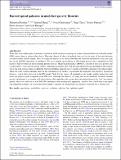Files in this item
Barred spiral galaxies in modified gravity theories
Item metadata
| dc.contributor.author | Roshan, Mahmood | |
| dc.contributor.author | Banik, Indranil | |
| dc.contributor.author | Ghafourian, Neda | |
| dc.contributor.author | Thies, Ingo | |
| dc.contributor.author | Famaey, Benoit | |
| dc.contributor.author | Asencio, Elena | |
| dc.contributor.author | Kroupa, Pavel | |
| dc.date.accessioned | 2022-01-17T15:30:13Z | |
| dc.date.available | 2022-01-17T15:30:13Z | |
| dc.date.issued | 2021-05 | |
| dc.identifier | 277461969 | |
| dc.identifier | 395343c0-f506-4b3c-9017-64333f8c3d57 | |
| dc.identifier | 85109540481 | |
| dc.identifier.citation | Roshan , M , Banik , I , Ghafourian , N , Thies , I , Famaey , B , Asencio , E & Kroupa , P 2021 , ' Barred spiral galaxies in modified gravity theories ' , Monthly Notices of the Royal Astronomical Society , vol. 503 , no. 2 , pp. 2833-2860 . https://doi.org/10.1093/mnras/stab651 | en |
| dc.identifier.issn | 0035-8711 | |
| dc.identifier.other | ORCID: /0000-0002-4123-7325/work/106397611 | |
| dc.identifier.uri | https://hdl.handle.net/10023/24681 | |
| dc.description | Funding Information: IB is supported by an Alexander von Humboldt Foundation postdoctoral research fellowship. BF acknowledges funding from the Agence Nationale de la Recherche (ANR projects ANR-18-CE31-0006 and ANR-19-CE31-0017), and from the European Research Council (ERC) under the European Union's Horizon 2020 research and innovation programme (grant agreement number 834148). EA is supported by a stipend from the Stellar Populations and Dynamics Research Group at the University of Bonn. For NLG, MOG, RHH, and LPH simulations, this work made use of the Sci-HPC centre of the Ferdowsi University of Mashhad. | en |
| dc.description.abstract | When bars form within galaxy formation simulations in the standard cosmological context, dynamical friction with dark matter (DM) causes them to rotate rather slowly. However, almost all observed galactic bars are fast in terms of the ratio between corotation radius and bar length. Here, we explicitly display an 8σ tension between the observed distribution of this ratio and that in the EAGLE simulation at redshift 0. We also compare the evolution of Newtonian galactic discs embedded in DM haloes to their evolution in three extended gravity theories: Milgromian Dynamics (MOND), a model of non-local gravity, and a scalar-tensor-vector gravity theory (MOG). Although our models start with the same initial baryonic distribution and rotation curve, the long-term evolution is different. The bar instability happens more violently in MOND compared to the other models. There are some common features between the extended gravity models, in particular the negligible role played by dynamical friction − which plays a key role in the DM model. Partly for this reason, all extended gravity models predict weaker bars and faster bar pattern speeds compared to the DM case. Although the absence of strong bars in our idealized, isolated extended gravity simulations is in tension with observations, they reproduce the strong observational preference for 'fast' bar pattern speeds, which we could not do with DM. We confirm previous findings that apparently 'ultrafast' bars can be due to bar-spiral arm alignment leading to an overestimated bar length, especially in extended gravity scenarios where the bar is already fast. | |
| dc.format.extent | 28 | |
| dc.format.extent | 10211618 | |
| dc.language.iso | eng | |
| dc.relation.ispartof | Monthly Notices of the Royal Astronomical Society | en |
| dc.subject | Galaxies: bar | en |
| dc.subject | Galaxies: evolution | en |
| dc.subject | Galaxies: spiral | en |
| dc.subject | Gravitation | en |
| dc.subject | Instabilities | en |
| dc.subject | QB Astronomy | en |
| dc.subject | QC Physics | en |
| dc.subject | Space and Planetary Science | en |
| dc.subject | Astronomy and Astrophysics | en |
| dc.subject | NDAS | en |
| dc.subject.lcc | QB | en |
| dc.subject.lcc | QC | en |
| dc.title | Barred spiral galaxies in modified gravity theories | en |
| dc.type | Journal article | en |
| dc.contributor.institution | University of St Andrews. School of Physics and Astronomy | en |
| dc.identifier.doi | 10.1093/mnras/stab651 | |
| dc.description.status | Peer reviewed | en |
| dc.identifier.url | https://arxiv.org/abs/2103.01794 | en |
This item appears in the following Collection(s)
Items in the St Andrews Research Repository are protected by copyright, with all rights reserved, unless otherwise indicated.

